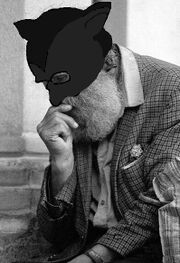Albanian interpretationalist cinema

Albania has long been known for its mastery over the silver screen[2]. Since 1739, Albania has been making high-brow foreign films (known as local films to Albanians), some being remakes of popular American films, others being remakes of other Albanian independent films that nobody saw the first time.
Albanian interpretationalist cinema is different from Albanian cinema in that the term "interpretationalist" is added, making the already incomprehensible Albanian films super-incomprehensible. These "movies" are Albanian versions of otherwise popular and shallow films already made in fancier, happier, better countries like Lithuania, Antarctica, and the alligator-infested Crocodile Republic.
Style
Albanian interpretationalist cinema focuses on the futility of life, the futility of work, the futility of happiness, and the futility of hopelessness. Usually set against the bleak landscapes of Shqipëtar, Shqipëri, and Shqipërisë, these films bring out feelings of hopelessness and futility. Plus, there are some talking birds that symbolize God in a few of them.
Shot in black and white and, confusingly, sepiatone, most Albanian interpretationalist cinema reorganizes the common concepts movies cover, and shines floodlights into those crevices of the human psyche we'd rather not dare to look, unless the production company of the original movie finds the Albanian directors and sues[3].

The content of Albanian cinema can be found written in tiny, poorly translated words at the bottom of the screen. If one sentence is missed, the entire point of the movie will be lost, along with all interest in this pretentious foreign film genre. Albanian movies have yet to be released on anything newer than two millimeter filmoid, first used in the Polish Inquisition.
There are four interpretationalist movies that are considered the flagships of this very old cinematic movement. Eastern European moviegoers recognize these movies by their names alone, and they have launched many successful careers in directing and acting in any place with bleak landscapes, where the director is trying to shine a floodlight in those places the human psyche would rather not dare to look. According to cinematic filmologists, 94 percent of the GDP of Albania is dedicated to making movies that shine a floodlight on those crevices of the human psyche we would rather dare not to look.
"Shøqpjr Nîuml Iskytncîøfphüûl"[4]
In 1998, Albanian director Antøn Schzjfkghr had already directed four other interpretationalist masterpieces. His most ambitious project, "Shøqpjr" began with a modest dream: to recategorize everything mankind knew about cinema, and to shine a floodlight into those places the human psyche would rather not dare to look. Whether it succeeded is up to future generations[5].
Opening with a shot of an ancient raven, we can see a lone 78-year-old character, Mytvlev Tyrgzky, who symbolizes the futility of hopelessness, crying and shaking over the grave of his puppy Dog. Soon, we realize that he is crying not only because of the loss of his dog, but also because of the loss of the love of his life to another man.
During a four-month trek on donkey-back, the most depressing of all hoofed animals, to the wedding to convince his love, whom the viewer never sees, to not go through with the wedding, Mytvlev suffers disease, loss, and hopelessness. By the end of the film, viewers are treated to a shot of the raven seen at the beginning, intoning in a dreadful tone those fateful words: "Neh, neh, neh; Pikërisht këmbadoras."[6]
"Kritik Pyetje Lidhur me Qytetarët e Huaj"[7]
In 1980, up and coming director Yrzgrk Hq had a vision: to not only shine a floodlight into those crevices of the human psyche we would rather dare not to look, but to throw a few aliens down there and see what happens. Regrettably, "Kritik" features only a single metaphorical alien on board a metaphorical space freighter and only two metaphorical action sequences.

Taking place on the plains of Panama City in the district of Meqytetarëtehuaj, Captain Yslev Mytosis stands shaking and crying over the grave of his iguana Iguana. A raven appears, signifying fleeting awareness. A flower growing in arid desert is shown, signifying rebirth. After eight non-stop hours of metaphors, we learn that the alien wasn't an invader from outer space: it was us... It was us all along. Other metaphors include another raven --symbolizing an action sequence-- a birth of an alien from someone's chest --symbolizing the futility of happiness-- and an iguana that stares eerily at the audience --symbolizing nothing at all, a metaphor for the compulsion of humanity to see and interpret things where there is nothing to be seen and nothing to be interpreted.
"Der Chat Dhe Gruaja Luftuar Krimin"[8]
In 2005, veteran director Ygrt Zxvcghq threw out everything he knew. Instead of sticking to the same old Albanian romantic comedy, Ygrt decided to shine a floodlight on those aspects of the human psyche we would rather not dare to look. Specifically, those parts of a prehistoric male actor not covered by his revealing leather cat suit.
"What was my motive?" Zxvcghq said in a recent interview. "I think mankind has had it too easy with Albanian interpretationalist cinema in the last hundred and fifty years. It was time I shined a floodlight on those aspects of the human psyche we would rather not dare to look. In this moving story of a lone man disfigured by society and by a cosmetic corporation, we see someone moving beyond the veil of shallow emotions into the nether-realm of deeply felt hopelessness. After losing his parakeet, Yongin goes on a metaphysical trial of fire, beating up exactly twenty seven metaphors before arriving at the metaphorical hideout of the metaphorical cosmetic company, where he metaphorically bends and turns under metaphorical lasers to fight, metaphorically, the main boss."
The person in charge of the metaphorical cosmetic company that started this whole mess, a raven representing God, actually considers physically assaulting the main character. In a rare twist, the raven only assaults him metaphysically.
"I Kompjuterëve Të Kafshëve Që Mëson Artet Ushtarak"[9]
In 2008, armed with the latest in computer-ish like technology that Albanian film directors could afford, Jurg Nwrzxlfakename embarked on a long, strange journey: a journey that would lead to him shining a floodlight on those parts of the unconscious that the human psyche would never dare to look.
"It did not start that way," Nwrzxlfakename said in a recent interview. "I was trying to make a movie that would actually make money for me and my family. After five minutes, I realized that this film about talking animals that learn martial arts needed an Albanian touch: something a non-Albanian could not provide... something that someone from outside of Albania could not do."
What starts out as a free-wheeling romp with some fluffy animals soon turns into a frightening journey into the unconscious. "I Kompjuterëve" provides a hegemony of hopelessness for the viewer, aged 7 and up. "I'm glad that it got an Albanian G rating. I was afraid that I had not shown enough of the underbelly of the human consciousness to the viewer!"
"I Kompjuterëve" is one of the highest grossing Albanian interpretationalist films ever produced, raking in eighty billion Yuduks (the Albanian currency) last year alone. The main character, Death, will be reappearing in the sequel, ""I Kompjuterëve Të Kafshëve Që Mëson Artet Ushtarak 2: Don't you be touchin' my Kompjuterëve".
Critical Acclaim
When they were released, international newspapers like the Globe Herald and the Minnesota Tribune-Herald hailed these movies as "veritable bramblefucks of ravens and floodlights" and "more depressing than that time I found out Santa wasn't real." Movies like these and others spawned the short lived American, Canadian, and Iranian interpretationalist movements.
The Future of Interpretationalist Cinema
The Floodlight Film Festival, held in ¨ƒˆ∆∂˜ß∂¨©, Albania every year in the dead of winter, has given space to new directors focused on shining floodlights into various places. The future of this art form is uncertain[10]. Given that ticket sales for all Albanian interpretationalist films were less than eight hundred billion Yuduks last year, Albanian film directors are now in more serious straits than most starving babies in the Congo.
Upcoming remakes include "Der Chat në Kapelë"[11]-- a riveting moratorium on hope-- and "I shpejtë dhe i furishëm"[12] --a film that shines a floodlight on aspects of street racing that humanity would rather not dare to see.
Footnotes
- ↑ Roughly translated as, "Dude, Where's My Car?" ...It's not a comedy.
- ↑ In Albania, it's called the "concrete screen"
- ↑ Doubtful, considering all Albanians are men with long beards who live in tiny studio apartments.
- ↑ "The Wedding of my Best Friend"
- ↑ Spoiler Alert! it succeeded.
- ↑ Roughly translated, "No, no, no. I'm a busy girl. I've got exactly fours days to break up a wedding, steal the bride's fella, and I haven't one clue how to do it!"
- ↑ "Alien"
- ↑ "Catwoman"
- ↑ "Kung Fu Panda"
- ↑ Correction: it's certain
- ↑ "The Cat in the Hat"
- ↑ "The Fast and the Furious"
| Film world: | Academy Awards ♦ AFI (American Film Institute) ♦ Bollywood ♦ Film colorization ♦ Golden Raspberry Awards ♦ Hays Code ♦ Horny Awards ♦ Internet Movie Database ♦ Lens flare ♦ Roger Ebert ♦ Screenwriting ♦ Gene Shalit ♦ UnReviews |
| Studios: | 20th Century Fox ♦ Disney ♦ DreamWorks ♦ MGM ♦ Paramount ♦ Pixar ♦ Sony Pictures ♦ United Artists |
| Narrators: | David Attenborough ♦ Morgan Freeman ♦ Movie Trailer Announcer Guy |
| Types: | Albanian interpretationalist cinema ♦ B-movie ♦ Cult film ♦ Film noir ♦ Independent film ♦ Parody film ♦ Sequel ♦ Snuff film ♦ Western |
| Featured version: 29 May 2009 | |
| This article has been featured on the main page. — You can vote for or nominate your favourite articles at Uncyclopedia:VFH. | |
